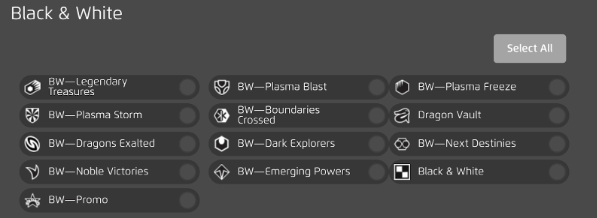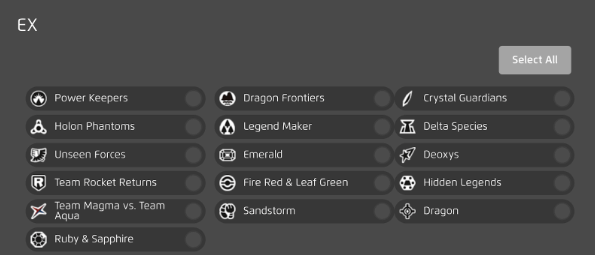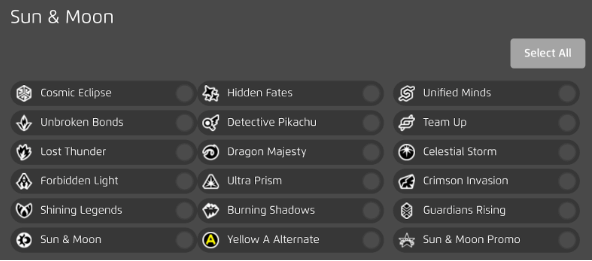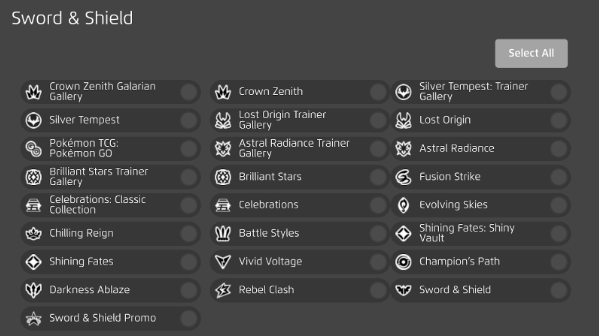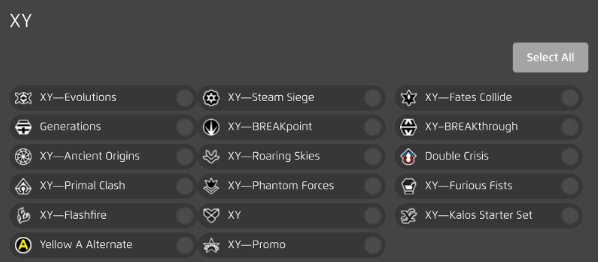In the world of collectibles, few franchises can rival the global phenomenon that is the Pokémon Trading Card Game (TCG). For over two decades, these charming creatures have captured the imagination of millions, inspiring a fervent fan base that extends far beyond the realms of video games and animated series. The Pokémon TCG has become a cherished pastime, drawing players of all ages into a world populated by these little “pocket monsters.”
As the popularity of Pokémon continues to soar, the demand for Pokémon cards has reached new heights. During the COVID-19 pandemic, prices shot higher as people acquired the cards to play and for investment. With a catalog of Pokémon cards that spans countless generations, promos, and rarities, the trading card market has developed into a dynamic ecosystem.
Unfortunately, this has led to some unscrupulous people creating fake Pokémon Trading cards. While the artistry and skill applied to these counterfeit cards can be impressive, there are definitely ways to spot these faux Pokémon cards.
In this comprehensive guide, I’ll delve into the intricacies of identifying fake Pokémon cards. By shedding light on key methods to tell the fake cards from the real thing, we hope to equip collectors and investors with the tools they need to avoid falling prey to counterfeit cards.
Basics of Pokémon Cards: Know Your Details to spot Fakes
There are several key factors to look for when determining the authenticity of a Pokémon card. Here’s a huge list of tips and tricks that will help you keep your collection authentic.
Rarity Levels
To identify fake cards, it's important to familiarize yourself with the various types of Pokémon cards and their rarity levels. If the rarity symbol on the card does not match the actual rarity level of the card, this is an easy way to spot a fake. Check out the full list of rarity levels and symbols in our article Pokémon TCG Card Rarity Explained Properly.
Set Symbols and Numbers
Each card set has a unique symbol and numbering system. Familiarize yourself with these details to spot inconsistencies on fake cards. Check out the full list of expansion symbols at the end of the article.
Card Material, Texture, and Spacing
Genuine Pokémon cards are printed on high-quality, glossy cardstock with a smooth finish. Fake Pokémon cards often feel thinner, flimsier, or have a rough texture. The card below is thinner, has a ruddy texture, and an obviously different background that is shiny and clearly not an official Pokémon card but a fake.
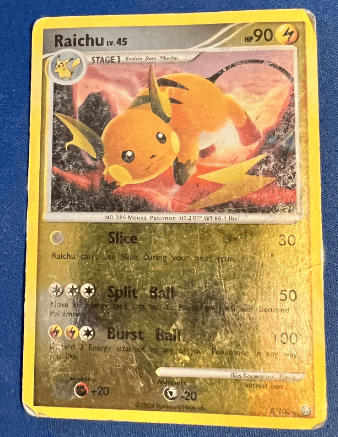
Color and Print Quality
Authentic cards have consistent coloration and clear, crisp text. Fake Pokémon cards may have uneven or faded colors, blurry text, or noticeable pixelation. Some of these differences are really obvious, while others are far more subtle, so look closely at cards you buy to make sure you feel confident there’s no telltale sign of a fake right in front of you.
Below, you can see two cards from the same era of the Pokémon TCG. The fake card on the left shows how the counterfeiters failed to capture the real shine of a holo background. On the right, the glow sparkles instead of looking like dust. Secondly, look at the “Poke-POWER” on each card. The fake one is hard to read, but the real thing handles the color and readability on this badge without a problem.
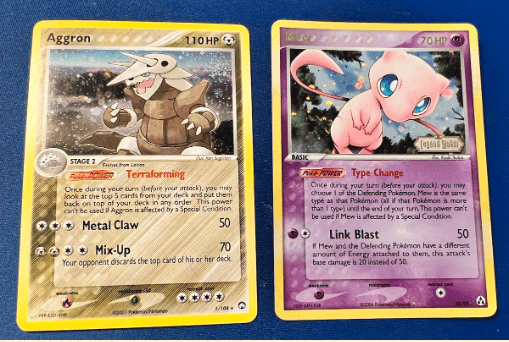
Misspellings, Grammatical Issues, Font and Text Changes, Stats Anomalies
One of the simpler ways to spot fake Pokémon cards is to notice typos and grammatical errors. The people who do this aren’t that careful! If the name of the Pokémon is wrong, that’s really obvious, but any word on the card should be correctly spelled and formatted to match the language the card is printed in. Of course, the fake card below is among the easiest to spot because any Pokémon player will know that’s Charizard and not whatever a “Caterpie” is. Of course, not every fake Pokémon card is going to be that obvious.
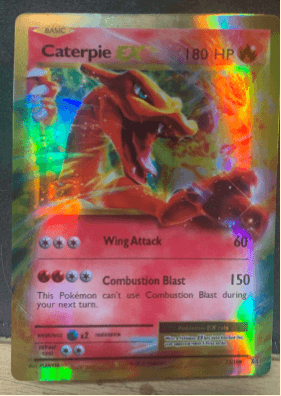
Fake cards often use incorrect fonts or have inconsistent text placement. Check for proper font and alignment of text in the card name, ability, and attack information. Even small typos can make a card an obvious fake, see the misspelling of “multitype” below on this Arceus card.
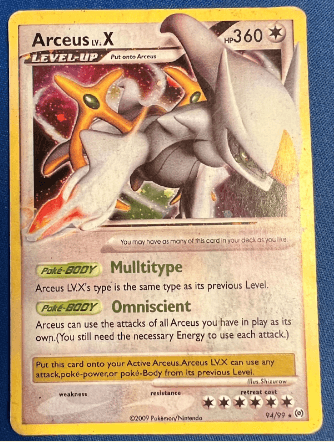
The last category here is for stats that do not match what the standard Pokémon card has - especially a number of hit points that look strange or very high to regular players and collectors. As nice as it would be to have this Pokémon on your side while playing the game, it’s definitely not a legitimate card because no Pokémon card has ever had anywhere near that number of hit points.
Online research suggests that the highest HP of any Pokémon ever allowed in a tournament was a Snorlax VMAX in the Sword & Shield series, which flaunted 340 HP. Thus, this 14,000 HP Serperior is not likely to be a real card.
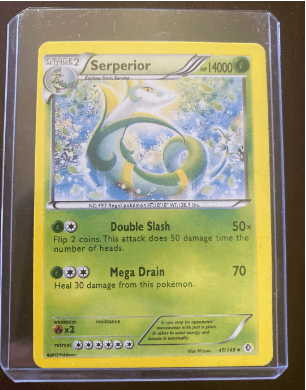
Holographic Pattern
Genuine holo cards have a unique, intricate pattern. Fakes may use a generic, low-quality holographic material or lack a proper pattern entirely. The example below has artwork that is too small for the card, too, but the cheap ‘holo’ effect is the biggest red flag.
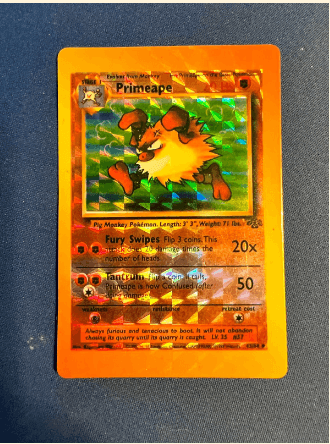
Another example here shows the real card on the left and a weird ‘holo-style’ card from a fake set. The ‘holo’ look for the fakes are flashy but they also ignore whether you can actually read the cards. Instead of adding a nice reflection, they are coated with an overwhelming shine when near a light.
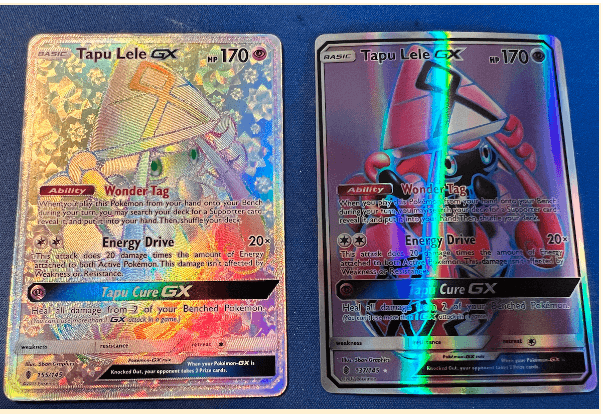
The following card is obviously fake because the Pokémon sets never included ‘holo’ standard energy cards. Cards that simply don’t exist are obviously going to be fakes so check any suspicious cards against the list of Pokémon symbols at the end of the article for verification.
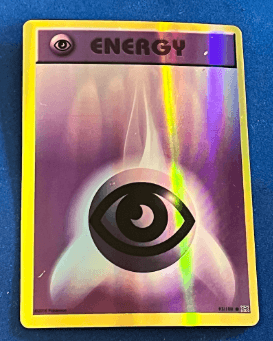
Card Back Design and Color
The back of an authentic card will have a clean, centered design with a smooth finish. Fakes may have a lopsided design or rough edges. The coloring is also an issue. In the image below, you can see the far right Pokémon card has the real color - a deep blue, almost indigo. The other two are fakes with a lighter blue that is clearly different from the official card back.
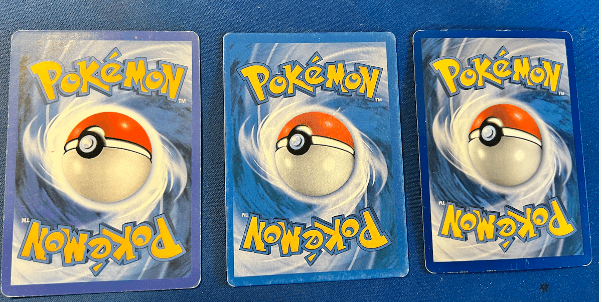
This also makes the using these cards in play problematic since you can easily tell the difference between real cards and the fakes. As you would expect, tournament play restricts the use of fake cards, especially since the language could be different, which could lead to rules questions and inconsistencies.
Additional Tips to spot fake Pokémon Cards
Pricing
If the price is so low that you can’t believe the deal you’re getting, it’s probably because the card is fake. This secret rare 2017 Mewtwo GX from the Shining Legends set sells online for around $100. This copy came in a box of a hundred cards from Wish for $10. Yes, that’s too good to be true.
The sloppy holo imagery is also a giveaway, but the idea that this six-year-old and valuable Pokémon card is still sitting in unopened boxes easily purchased online for about $10 should also be an indication that this is a fake.
Remember that you can always look up pricing for graded and ungraded cards on the Cardbase App for reference to see if the pricing seems way off.
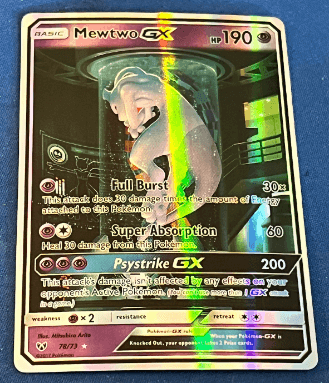
Know the History of the Card
Understanding the origin of a particular card can help you verify its authenticity. For example, if you know that a specific card was only released in a particular set or promotional event, you can use this information to spot fakes.
Remember, being cautious and thorough in your research will help protect your collection from fake Pokémon cards. Building connections within the Pokémon card community and staying informed about the latest trends and releases will also serve you well in your quest for authentic cards.
Ask Local Game Stores and Collectible Shops
Supporting your local game stores and collectible shops can be an excellent way to connect with other collectors and players in your area. These establishments often host events, tournaments, and trade nights, which can be valuable opportunities for learning and networking. When you develop a relationship with these local folks, you can learn to trust them (and vice versa) to assess fake or real Pokémon cards together.
Ask the Internet
When in doubt, consult the Pokémon card community online for help. You can post a picture of a card you suspect is dicey online and ask with #pokemon hashtags to see if other people following it will come and answer your questions. Do this on Facebook groups devoted to Pokémon, on Instagram, or on forums like PokeBeach, PokeCommunity, and Efour.
The people on these sites can be excellent, knowledgeable resources who can help verify the authenticity of your cards. In many cases, experts in the hobby enjoy showing off their expertise. Stay cautious, especially if someone’s assessment comes with an offer to buy your card.
The Pokémon Company International also maintains official websites that provide valuable information on card sets, products, and events. Utilize these resources to stay up-to-date on the latest releases and news.
Fake Graded Pokémon Cards
One of the best ways to verify that you have a real Pokémon card is to get it professionally graded by PSA or BGS. However, some sneaky individuals try to create fake PSA and/or BGS slabs with counterfeit cards inside them. They are crafty, trying to add the good name of PSA into their scam. There are ways to spot this, though:
- First off, if the price is well below what you see on Cardbase’s pricing level for the card, be suspicious. While ungraded card pricing can be all over the place, graded card pricing is usually in-line with estimates. If it looks like a deal that’s too good to be true, it could be a scam. Remember that the card pages on Cardbase can show you actual pricing for different grades and ungraded cards if any are on record, giving you fairly specific information on pricing.
- A PSA graded card’s front label holds some details worth familiarizing yourself with. The PSA Lighthouse logo has a colored illumination effect you can check by shining a light on its textured portion of the label. If you can’t see this effect and the logo lacks the pattern, you may have a fake.
- PSA’s label also includes the security of a Fugitive Ink graphic pattern. The pattern will be faint, but this kind of ink is designed to show any attempts to add to or modify it in some way. This has been used by PSA since 2017 to help prevent nefarious people from copying their labels. This innovation makes it quite expensive for a counterfeiter to try to recreate, so it’s one of the best ways to spot a fake.
- Keep an eye on the ‘S’ in ‘PSA’, particularly the red color. Many fakes miss this letter being in a different color, font and that it’s overlapping the other two letters. If it looks different, proceed with caution. Take a look at the card below, which looks solid but the PSA logos on the label are not standard for the company’s output. This was judged a fake by online experts who noted that no version of PSA’s labels ever looked like this one.

- Another tough one to reproduce is the on-plastic PSA logo that some might miss. There’s a small PSA logo embossed on the bottom right side and it appears on both the back and the front of the slab. If you don’t see the logo cut into the slab, you likely have a fake graded card.

- The PSA label on the back has more security features. There is a UV PSA logo that is reflective like the front logo. This is an innovative security measure PSA included, in addition to more Fugitive Ink, and a QR Code, they included to add more than just a serial number to the slabs because they were getting faked. The QR Code should send you to the PSA site to help identify the registration and ownership.
- When you scan the QR code, ensure that you check that all of the information listed on the website, including certification number, condition, and any special designations are connected to what’s on the card.
The cards look very similar below, but the left-hand card is real and has the official PSA logo and the Fugitive Ink pattern in place. The right-hand card has poorly copied the PSA label, lacks the Fugitive Ink pattern, and the coloring on the card isn’t as deep as the real card.
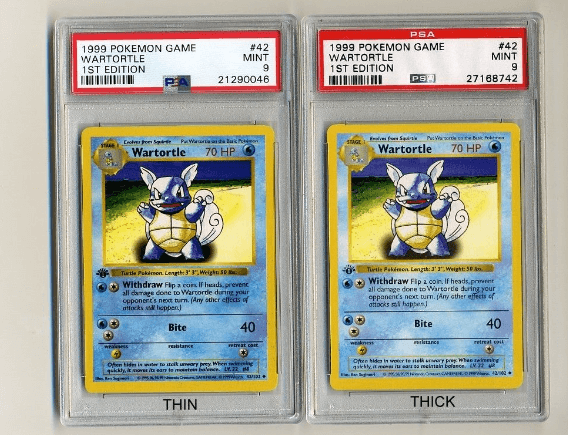
Fake Pokémon Booster Packs and Sets
Believe it or not, some sellers on the less reputable retail sites sell fake Pokémon booster packs or boxes of cards. There are some simple ways to avoid getting saddled with these faux boosters and packs of cards.
- Be cautious about purchasing from online retailers like Temu, AliExpress, and Wish.com, where lots of sellers of counterfeit goods set up shop. Even Amazon.com has had a lot of sellers flood onto their platform with products that are not legitimate, although they have done a major crackdown in the last few years to eliminate a lot of these companies.
- Like the references to the cards above, look closely at the artwork and text on the packs in the pictures. If there are misspellings, different fonts, variations in color, and even the shape of the packs, you may be looking at a fake pack.
- As with individual cards, pricing is another dead giveaway. Pokémon booster packs and sets are not subject to much variation in price due to the Pokémon Company’s rules for retailers. If you’re seeing much lower prices than what you traditionally pay for your Pokémon cards, there’s a good chance you are looking at a listing for fake cards.
The box below was purchased on AliExpress for a few dollars. While the cards are playable in a casual game, this set contains more than 200 fake Pokémon cards for which the publisher and creative team behind the cards are never paid. If fakes flood the market, there is no way for the people who make the cards and game to flourish, which hurts the hobby.
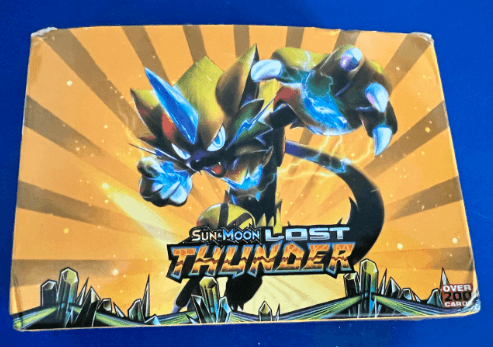
What If You Already Bought Fake Pokémon Cards?
Nobody’s perfect. As you can see from the long list of details about spotting fakes, there are a lot of counterfeit cards out there. It’s easy to make a mistake identifying a card as fake, especially when you haven’t seen the card in real life before. Prepare yourself the best you can, but also accept that we all make mistakes sometimes and you might end up with some fakes in your collection.
If you inadvertently buy a fake Pokémon card, contact the seller and explain the situation. They may be unaware of the issue and could offer a refund or exchange. If they refuse to cooperate, you may need to escalate the issue through the platform's dispute resolution process.
eBay and most reputable retailers will offer you a refund if you get fake cards from a seller who misrepresented what they were selling. Be careful about purchases from some of these upstart retailers like Temu, Wish.com, and AliExpress, where they may not consider their company responsible for ensuring a refund for sale of goods that were not as advertised.
Before purchasing expensive cards, make sure you understand the return policy and what recourse you have if the cards end up being fake. Always try, though, don’t fall victim to these scams and do nothing. At least put in the effort because, even if you don’t get satisfaction from a retailer, you can potentially disrupt an unethical seller who is ruining the hobby for collectors and investors alike.
- In the U.S., the Better Business Bureau appreciates feedback on retailers who are not honoring their sales to customers. A report doesn’t take long and it can help make sure other people are not tricked into buying fake Pokémon cards, so it’s worth your time to contribute to the community by promoting safe buying experiences.
- On eBay and other platforms with seller feedback, be sure to report unscrupulous sellers so the feedback system will prevent them from scamming other collectors. Always check seller feedback. Although a positive rating is important, I like to read a few lines of actual feedback to make sure people have affirmed the seller’s trustworthiness.
- Producing, selling, or distributing counterfeit Pokémon cards is a violation of copyright law and can result in legal consequences for the company selling them. You can report companies selling counterfeit cards to the Pokémon Company or local police to get help in making sure the market is not flooded with more fake cards.
Fake Pokémon Cards Hurt the Hobby
Spotting fake Pokémon cards is an essential skill for any collector or player who likes to buy and sell on the market. By familiarizing yourself with the various aspects of genuine cards and leveraging the expertise of the Pokémon card community, you can ensure the authenticity and value of your collection is maintained.
A healthy rule of thumb is this: If you are spending more on a card, spend more time examining it, too. Don’t let the fake card you do actually buy be one that costs you hundreds or thousands of dollars.
The world of Pokémon card collecting and investing is not just about the allure of owning rare, valuable pieces; it's about the shared joy of a hobby we all love. We can all contribute to maintaining this hobby when we remain vigilant in identifying fake cards.
By feeling a collective responsibility towards the authenticity of Pokémon cards, we can safeguard our investments while giving all players, collectors, and investors a better overall experience. This helps promote a healthy hobby where people don’t feel burned when they overpay for a collectible that isn’t real.
Stay vigilant and happy collecting!
Appendix: Pokémon Symbol Guide
The official Pokémon TCG search page shows you all the symbols by type, rarity, and expansion.
Rarity Options

Pokémon Types

Expansions
